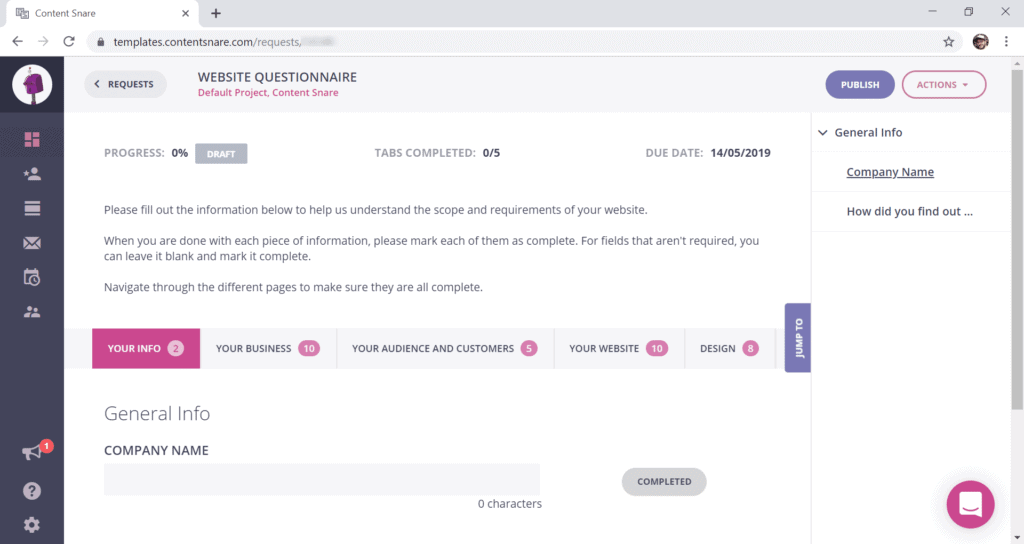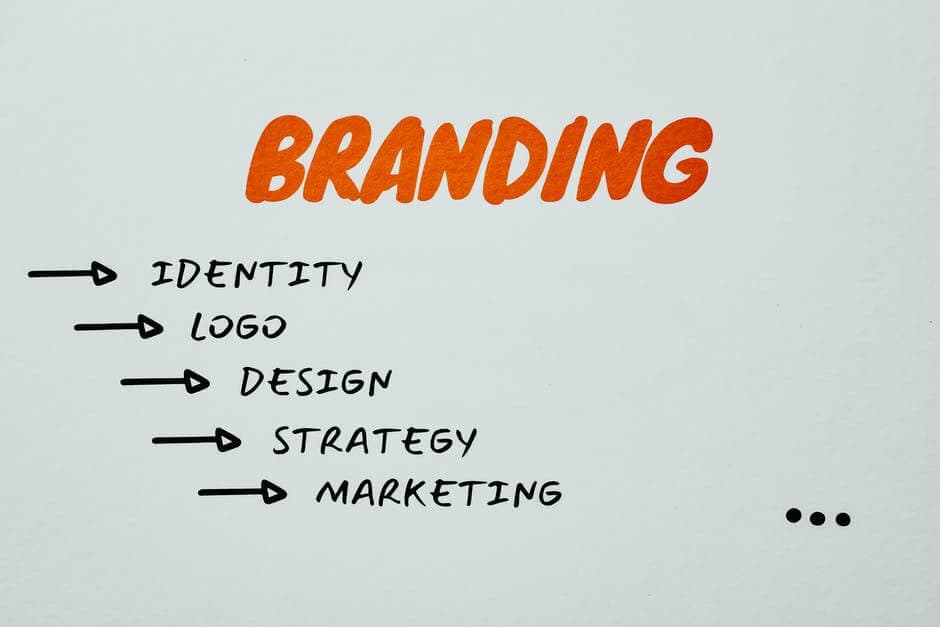In this post, you’ll learn how to create an effective branding questionnaire you can use to help your clients build their brand identity. At the end of this post, you’ll find sample questions to ask in your questionnaire to get the most out of your research.
What is a brand or brand identity?
Your brand (or brand identity) is more than a logo, a company name, the way you word things, or visual elements you see on websites like fonts and colours. Your brand is essentially your personality — who you are to your customers. It represents how you’re different, why they should engage with you, and whether you are right for them.
Why creating a brand matters
A great brand identity sets an organisation apart and creates intrigue and curiosity.
Creating a brand is important since it’s like a roadmap for a business or organisation. It defines the organisation’s direction and purpose. A brand also enables and empowers staff to interact with customers and each other in a way that is consistent with a company’s brand values.
To effectively create brand collateral, you first need to understand an organisation’s values, vision, mission, goals, objectives, and ethos. You need to understand what sets that brand apart from its competition and what makes it unique for a target audience before going ahead with any branding efforts.
Collect branding information from your clients
Building your branding questionnaire is easy with Content Snare. Just use the branding questionnaire template and send it off to your clients to get the answers you need to start building their brand.
Why create a branding questionnaire?
A branding questionnaire, similar to a creative brief, helps you work with clients on developing their brand or conveying their brand appropriately. In today’s post we’re going to look at how to construct a branding questionnaire to help your customers brief you on their brand.
Let’s dig into how to construct a branding questionnaire to help your customers brief you on their brand.
What is a branding questionnaire
A branding questionnaire is a series of questions you ask your clients (or prospects) to gain an understanding of their existing brand, their story, and what they want their brand to be.
You can use a branding questionnaire for a few different marketing projects. You can use one to develop brand collateral or to work with clients on establishing a new brand, or even to refresh an old one.
A typical initial branding assessment asks about these aspects of a company:
- Values
- Vision
- Mission
- Strategy
- Marketing initiatives
- Ethos
- Team
- Goals and objectives
- Target customers
- Products and services
- Competitors
- Unique selling proposition (what makes them different)
- Budget
- Typical words customers use to describe the company or brand
- The industry it operates in
If clients are looking to rebrand, you can use your questionnaire to ask more about:
- Any issues or problems they’ve bumped up against with the current brand
- Who they want to be perceived as in the market against competition
Why using a branding questionnaire is a good idea
Benefit #1 – Avoiding project failure
The main reason why using a branding questionnaire is a good idea is because it helps you understand the client’s brand and ensure that your project isn’t a massive failure. By asking the right questions, you can be sure you’re on the right track.
Benefit #2 – Easier sales
Once you have a thorough understanding of the client’s strategic direction it’s much easier to tune into what they need from you and create a value proposition that adds value to their objectives. It’s way easier to sell to an organisation that sees value in the questions you’re asking to uncover their key issues and help them achieve their goals.
Benefit #3 – Filtering out bad clients
How your clients answer your branding questionnaire will give you an indication of what the client is like to work with. Are they disorganised and unclear in the way they communicate? Do you have a bad gut feeling about how it’s going to be to work with them? You can test all of this out in a well-worded questionnaire for branding (and this applies to all types of questionnaires too.)
Benefit #4 – Setting cost expectations
A branding questionnaire will also establish the client’s expectations in terms of budget. If it’s clear they need their brand completely redeveloped before they work with you on a website or brand collateral, this is the time to raise this with the client and let them know how big of a scope the project will be. If they have unrealistic expectations in terms of pricing, you can choose to refer them to someone else who may be a better fit.
How to create your branding questionnaire
A questionnaire is just a kind of form. The usual methods for building one that we see regularly are:
- Content Snare
- Online forms tools
- Documents
- Fill-able PDFs
- Printable PDFs
We highly recommend using an online tool like Content Snare, Typeform, or Gravity Forms. This way you can avoid unnecessary printing (and headaches) and keep your processes as tight and automated as possible.
Using Content Snare means that clients can complete the questionnaire in several sittings, as it can be unreasonable to expect they get it done in one go. Your clients will love you for making their lives easier.
Tools to build your form
If you don’t already have a forms tool of choice for creating your survey, there are a few options.
Google Forms

Google Forms is a great tool to start with. It works no matter what platform you are using, it’s easy to set up and it’s free. If you have a Google account, just go to drive.google.com and create a new form.
The designs are fairly simple, but it’s easy to create a form quickly.
Gravity Forms
Gravity Forms is a WordPress plugin that has more features than Google Forms. At the end of this post, there is a place to download our exact branding questionnaire template that you can import right into Gravity Forms.
Typeform is a stand alone desktop form application that has many diverse templates and designs, is highly flexible and can even include payment transactions via Stripe. However, it can be tricky to set up and they must be completed in one sitting.
A note of caution on forms
Try to avoid making a form too long. Filling out a large form can sometimes intimidate clients who are already pressed for time and capacity. Some clients will procrastinate or abandon a longer form because it takes too long to fill out.
A way to address this is to use a system that enables clients to complete their questionnaire in stages. If they can save their work and go back to it later that will be appreciated by your clients.
Content Snare

Content Snare allows clients to fill things out in their own time. If they don’t do it in one sitting, they click their link anytime to come back and resume filling it out.
To ensure they don’t forget, it automatically reminds them until they’ve completed the form. This results in more people completing your branding questionnaire.
Content Snare helps with much more though.
Collecting content from clients is the biggest bottleneck in moving many marketing projects along. It holds up projects and causes payment delays.
Content Snare makes this process easy and can also be used for your branding questionnaire.
This helps you get your time back, complete more projects and get paid faster.
Create your questionnaire
Get two for one and build your branding questionnaire with Content Snare. It’s a tool that also helps you collect content from clients, which is the biggest bottleneck in the design process.
Question List
Now you know how a branding questionnaire can help you understand your client’s business and your options for building one, let’s dig into questions you can ask in a branding questionnaire.
How long your questionnaire is depends on your strategy. If you’re trying to do lots of projects at a lower price, you might want to get all the info for their branding upfront.
If you’re doing higher priced branding or design projects where you include strategy discussions, the questionnaire might just be an initial filter to weed out bad clients and to give you enough info for an in-person meeting.
Here are our 15 of our favourite questions and why we ask them:
1. What are your organisation’s top 3 core values?
This question helps you see what is guiding the organisation and whether their current branding is consistent with their values.
2. What is your vision?
This question is about where the organisation sees the brand going over time.
3 . What is your mission?
This is about the actions the brand will take to fulfil its vision.
4. What are your top 3 objectives for your brand?
Objectives are specific milestones the organisation is working towards to accomplish its mission. This shows how organised and intentional they are.
5. Do you have current brand collateral and guidelines?
This question gives you an idea of where they are at right now and helps you gauge how much work is required from you.
We like this question because it can also be used as an upsell opportunity if they need help developing their actual brand or their brand content.
We use multi-choice format for answers to this question with the following options:
- Yes, they’re in documents ready to go
- Nope, but I will be putting them together
- Nope, and I need help with them
6. What are your products and services?
This is probably the most obvious question of the entire questionnaire. You’ll need a very solid understanding of what their business does to kick ass on their branding materials.
7. Who are your ideal customers?
This question is so you know who your clients are targeting.
8. Why are they visiting your website? What’s their #1 goal?
You might split this into several questions, but this one is important as every business is different. Some just want to get the client on the phone, some want their clients to purchase online or simply enter their email somewhere.
9. What’s your average sale value (approx) -or- What is the lifetime value of your customer?
This one is a sneaky one you can also use to your advantage as a market. If you know that someone makes $20k from a client, that’s something you can use to quantify the value in the site you are building. If the website helps them get just one more client a year, it’s much easier to justify a $10k price tag.
10. List 3 brands you like, preferably in different industries and include dot points what you do and don’t like for each
It’s important to find out what they do and don’t like. So many times they say they like a brand, but it turns out they only like the logo and hate the rest. If you based your brand design on that, you’re in trouble. It’s better to find that out early.
11. List out the branding components you want
This one is for the clients that already have a pretty good idea, or to help the other ones think about it some more. What they write here doesn’t have to be set in stone.
12. Do you have any concerns or worries?
This one is gold! This is where they tell you exactly what you need to address when you talk to them later.
13. To call your brand a success, what would need to happen?
Just like the above question, this too, is gold. It helps you craft both your pitch and make sure the branding achieves your clients’ exact goals. It can also help bring out hidden expectations that wouldn’t have come up otherwise.
14. What is your budget?
The ultimate client filter. We use a dropdown list where the smallest amount is “<$2000”. Generally, you’d set the bottom level as the budget you don’t want to work with and may simply refer them to someone else.
15. What is your timeframe/launch date?
Just in case you get a surprise 2 weeks where everything needs to be finished in 3 more days.
Interpreting the results to filter clients
If you’re using your questionnaire as a client filter as well, here are some tips for deciding whether or not to proceed.
Sometimes it’s really obvious that a client isn’t going to be a good fit. For example, if they list out 25 brand components and give a budget of $500.
But there are some things you can look out for in the results which might indicate a storm brewing.
- If they are highly critical of other agencies or developers. Sometimes this may be fair criticism, but sometimes it’s just a reflection of the client never being happy.
- Excessive detail in what they want. If they aren’t leaving anything open to you, there’s a real chance they are going to pick apart everything you do.
- Or even worse “I’ll know what I want when I see it”.
- Silly words to describe what they want. If they want the site to “pop”, “have more pizzazz” or “be maybe 20% more playful.”
- Their target audience is “everyone” (this might just mean they need some business coaching).
- In the free-text boxes, they’ve written essays.
- If you just get the feeling their expectations don’t match the budget.
Yes, it’s OK to trust your gut. That bad feeling you get is the result of hundreds of thousands of years of decision-making evolution
Get the full question list and ready to use questionnaire
Want to see the full list of questions we ask on our website questionnaire?
Free to use and modify for your own business.
Next steps
If you haven’t already got a branding questionnaire, go and create one.
If you already have one, read through it and see if anything needs adding or adjusting.
Read through our questions to see if there are any that make sense for you to add to your branding survey.
Have any awesome stories or tips you’d like to share? Drop them in the comments below, and maybe we’ll invite you on the show to share them!



